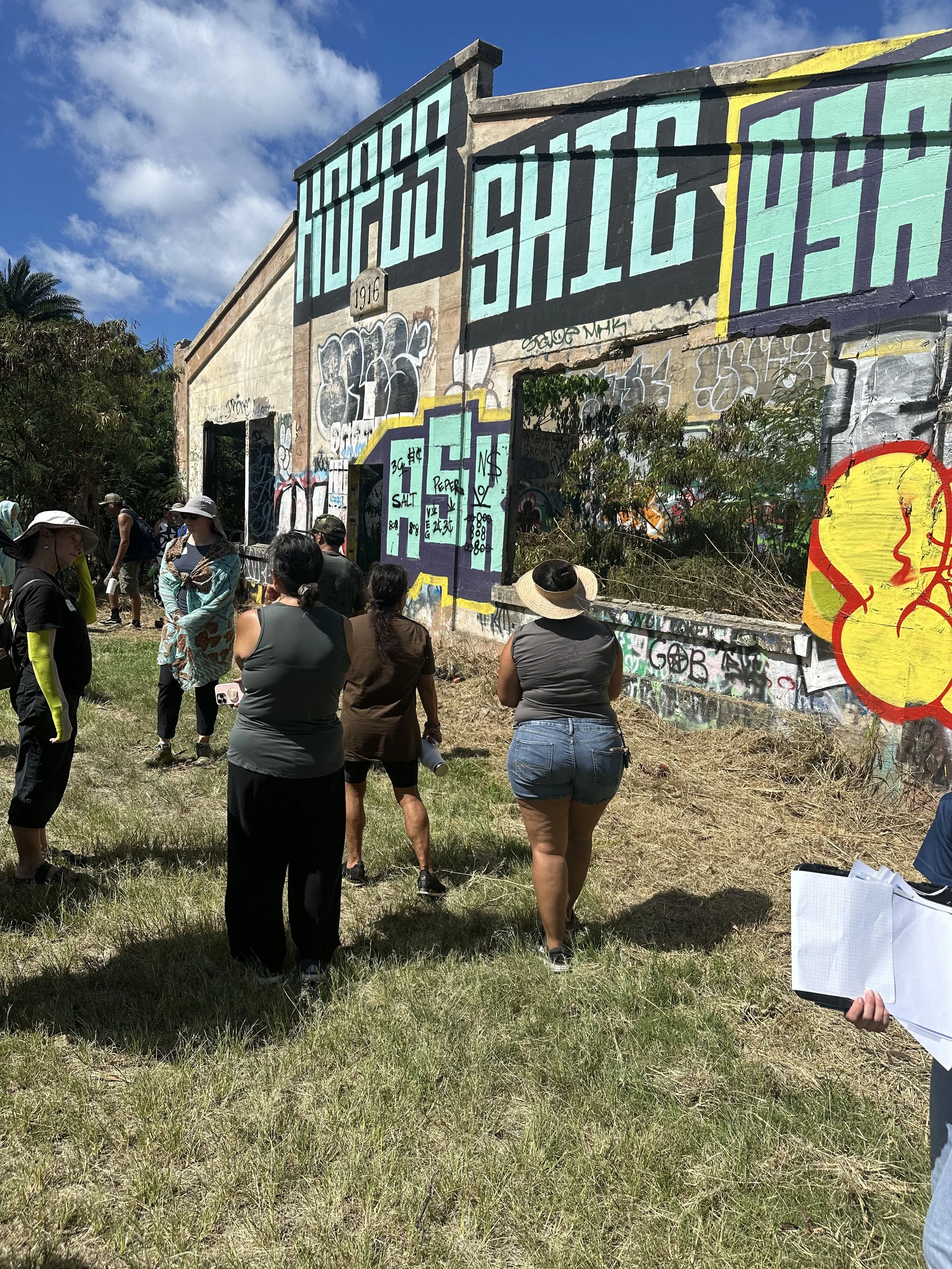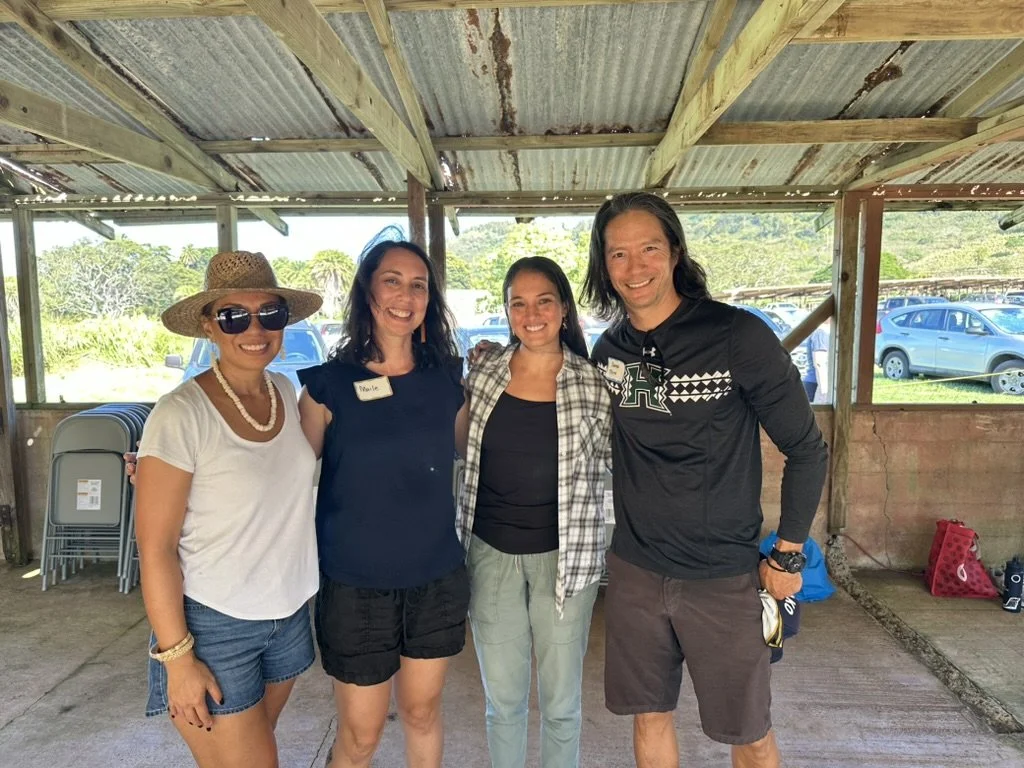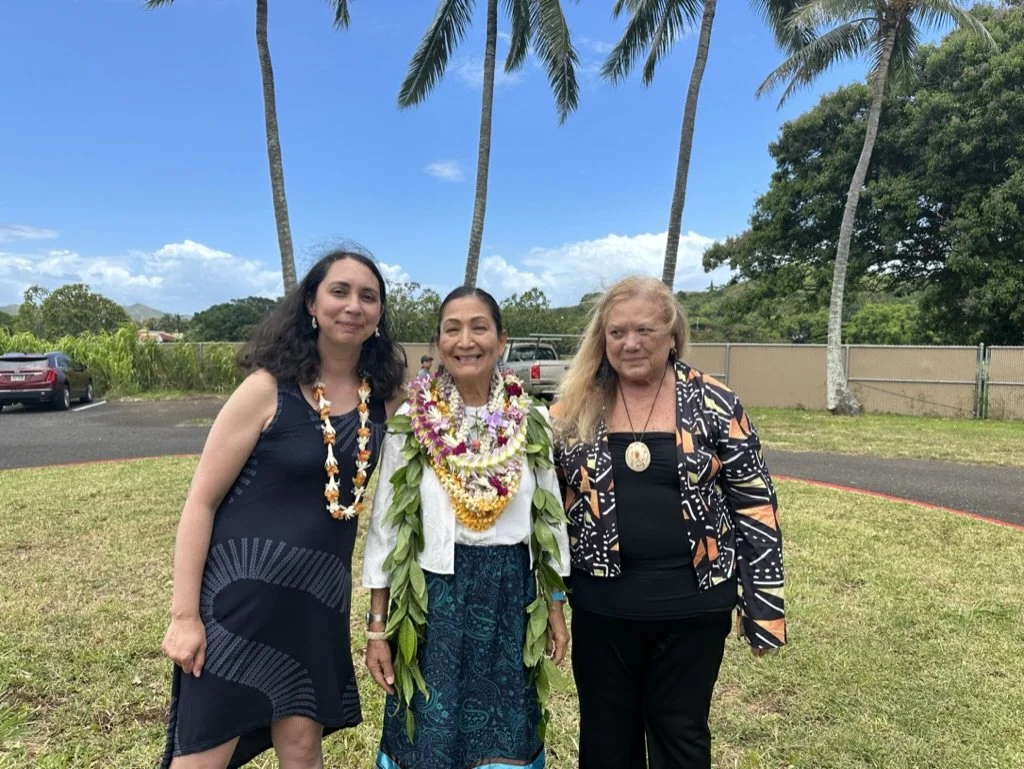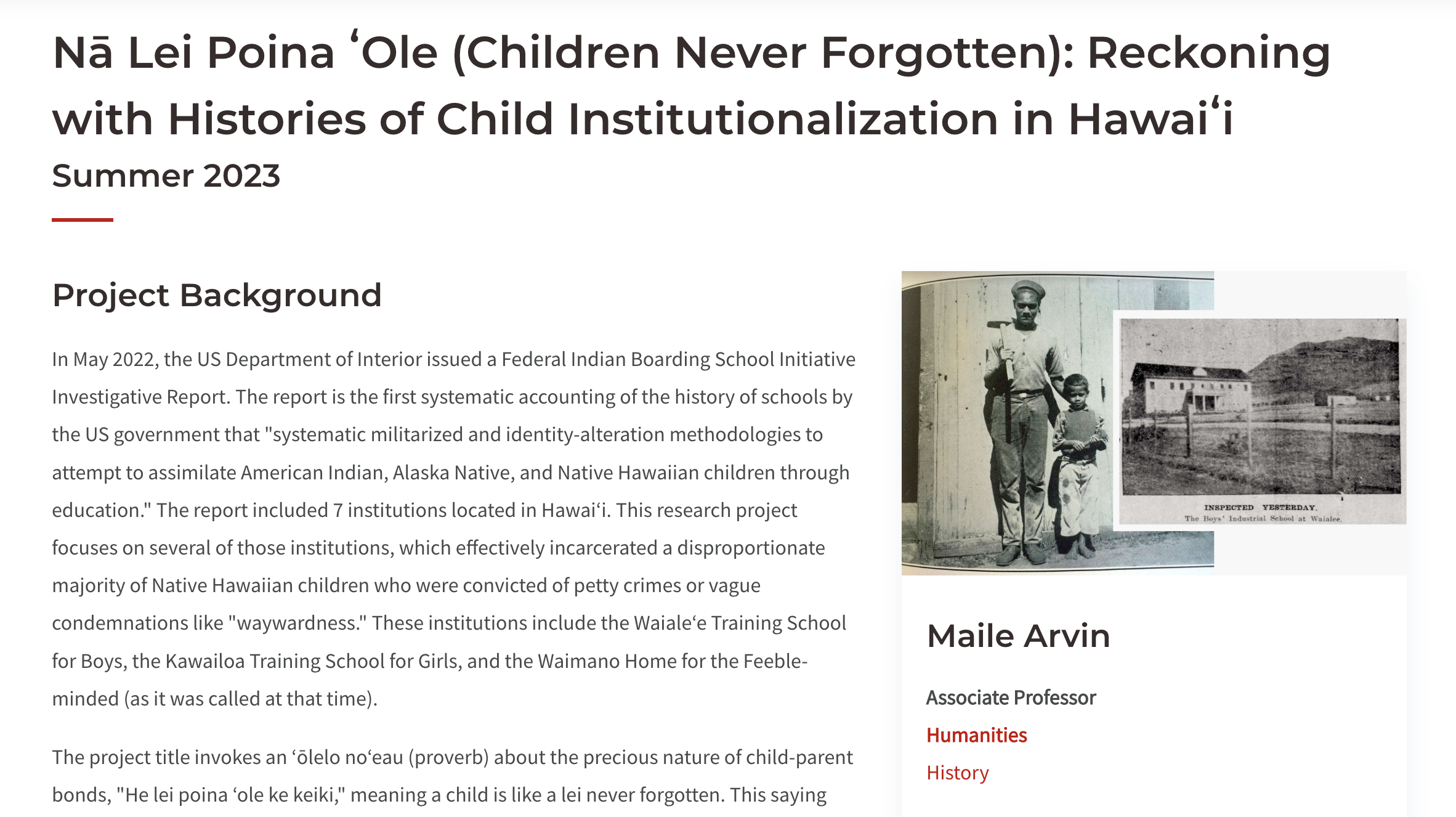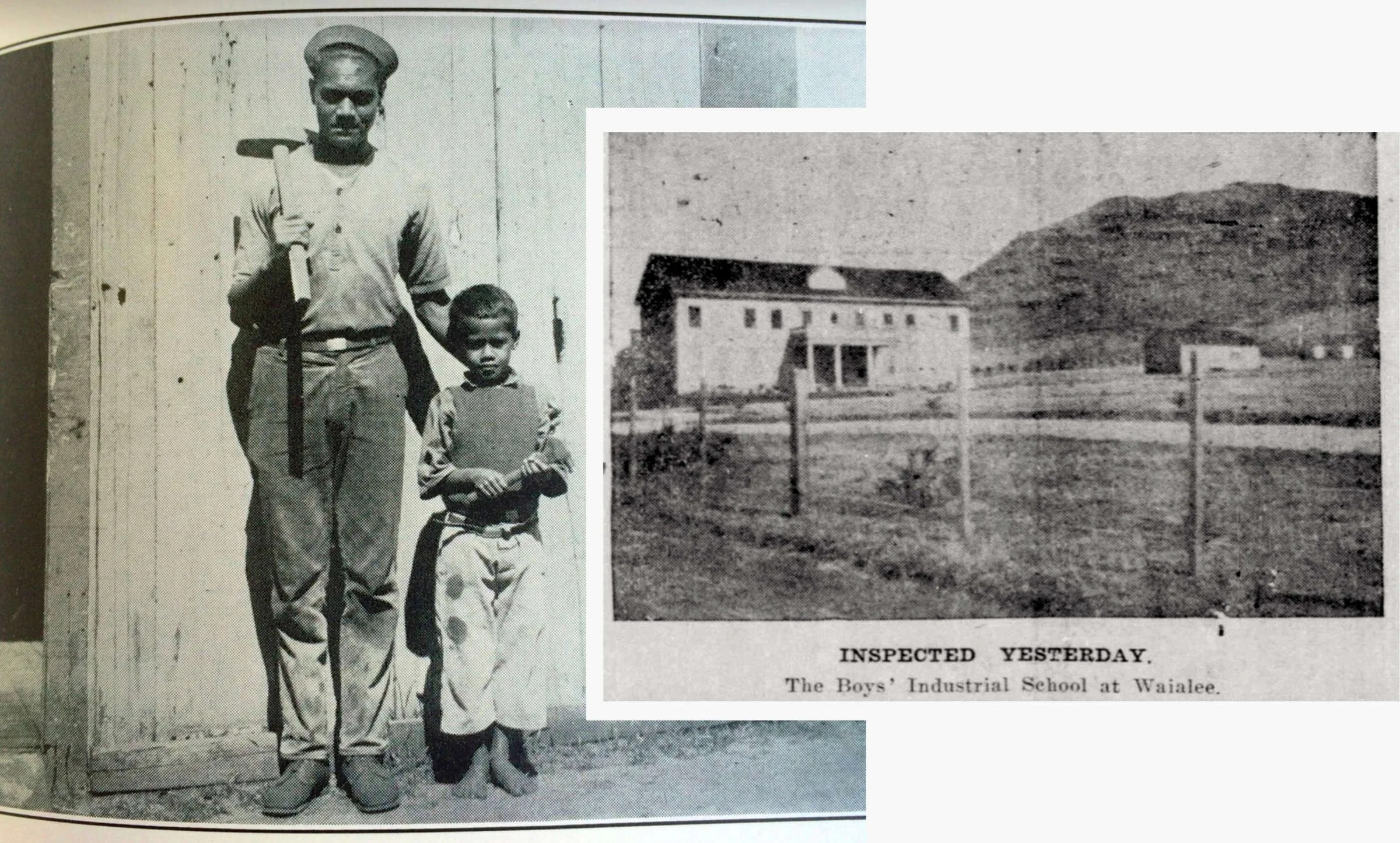Updates, with a full heart after connections at Waialeʻe
What a whirlwind time it has been for everyone. This blog post shares a few updates on recent events and a new publication.
What a whirlwind time it has been for everyone. This blog post shares a few updates on recent events and a new publication.
Mahalo e Waialeʻe
Three weeks ago, on Saturday Oct 19th, many of us gathered at Waialeʻe. We had a wonderful day sharing space and manaʻo with folks from the North Shore Community Land Trust, UH Sea Grant, KUA, Townscape, and most importantly, many community members who have long-standing pilina (relationships, ties) to Waialeʻe, or who were descendants of boys formerly incarcerated at the Industrial School for Boys. Townscape is working on a report summarizing the community input gathered that day, which we will share publicly soon. Mahalo to everyone who made the day possible and meaningful.
You can find photos and videos of the day on our Facebook and Instagram pages. The ʻāina of Waialeʻe is so beautiful, as is the work NSCLT is doing to restore the loʻi kalo (taro fields) and Kalou, the loko iʻa (fishpond) to lako pono (a state of abundance). You can join the work on the last Saturday of every month. The next one is Saturday, November 23rd. Find more details and sign-up here. Also be sure to check out a recent blog post by Eliana on a remarkable story of one boy who swam six miles out to sea to get away from the industrial school.
The Biden apology & NABS events in Hawaiʻi
A week after our time at Waialeʻe, President Biden apologized for the federal government’s role in federal Indian boarding schools. Though it may have come as a surprise to some, we have to understand the apology within at least two larger contexts. First, there has been a long history of advocacy for federal actions like this, by groups including the National Native American Boarding School Healing Coalition (NABS). Those efforts have born some fruit under the leadership of Department of Interior Secretary Deb Haaland, who spearheaded the release of two reports (one in 2022 and one in 2024) on federal involvement in “federal Indian boarding schools.” Several institutions in Hawaiʻi were included in this report, including the Waialeʻe Industrial School for Boys. Second, the apology was undeniably an effort to rally support to elect Kamala Harris. Even if she had been elected, we cannot know what the follow-through may or may not have been; but the uncertainty is even greater under a second Trump presidency.
I have written before about the similarities and differences between the industrial schools I study in Hawaiʻi and Native American boarding schools, and what the report gets wrong about Hawaiʻi. I will simply say here that the way that Native Hawaiians have been included in the federal reports on boarding schools and larger initiative leaves a lot to be desired. Many of you may have heard that there is a series of events hosted by the National Native American Boarding School Healing Coalition in Hilo and Kāneʻohe later this month. To be clear, I am not personally involved in those events; nor is our project Nā Lei Poina ʻOle involved. I support the overall cause of healing from institutional violence and intergenerational trauma - indeed, this is at the heart of this project - and greatly respect many who are participating in these events. I also think the November events are part of a top-down process that is not fully prepared to engage Native Hawaiian history with the care and time our communities deserve. How things proceed matter. This is lifetimes long, generations of healing work. I am interested in it for the long term, not just this election cycle.
New open-access article published
After many years in the works, my first academic article on the history of industrial schools in Hawaiʻi has been published, in open-access format here. Here is a sneak preview, and the full citation below.
In 1929, Dorothy Wu, a multiracial Native Hawaiian and Chinese teenager, suddenly found herself a ward of the Salvation Army Girls’ Home in Honolulu, Hawaiʻi, then a US territory. Until her institutionalization, Dorothy had worked as a maid in the home of Princess Abigail Campbell Kawānanakoa, a member of the aliʻi or ruling, royal class of the formerly independent Hawaiian Kingdom. To Dorothy’s bewilderment, the Princess abruptly fired Dorothy for “associating with boys,” and recommended her commitment to the Girls’ Home, where she could be “better cared for.” Dorothy found the Salvation Army matrons mean. She complained that they discriminated against “darker girls” like her. After six months, Dorothy ran away. Her escape soon landed her in juvenile court, which sentenced her to the Kawailoa Training School for Girls, a recently opened juvenile detention facility, where matrons worked to shape “wayward girls,” the majority of whom were Native Hawaiian and/or Asian, into “proper” and modern American women.
Arvin, Maile. “Replacing Native Hawaiian Kinship with Social Scientific Care: Settler Colonial Transinstitutionalization of Children in the Territory of Hawaiʻi.” Chapter. In Empire, Colonialism, and the Human Sciences: Troubling Encounters in the Americas and Pacific, edited by Adam Warren, Julia E. Rodriguez, and Stephen T. Casper, 123–52. Cambridge: Cambridge University Press, 2024.
E Hoʻomanaʻo Mau: Memorializing the Boys of Waialeʻe
Please join us on Saturday, October 19th, 9am-3pm at Waialeʻe Lako Pono for an event to gather community input on how to appropriately memorialize the history of the Waialeʻe Industrial School for Boys (1903-1950). RSVP here, and please share with anyone who has ties to or interest in the history of the Waialeʻe Industrial School for Boys.
New logo & other updates on our website
A hala and ʻilima lei for beloved keiki never forgotten
If you have visited our website or social media accounts lately, you may have noticed some new features. We are especially excited to share a new logo for our project!
Designed by Kanaka Maoli artist and scholar Makamae Sniffen, embodies the ʻōlelo noʻeau “He lei poina ʻole ke keiki,” from which we take our project name. It features an image of a child with their arms clasped around a parent, as well as a flower lei of hala and ʻilima. These pua were traditionally associated with Waialeʻe, the site of the boys’ industrial school, as documented by Kawela Farrant. Hala further signifies moments of great transition, including passing away, while ʻilima is the flower symbolizing the island of Oʻahu. The keiki faces the audience - reminding us of their resilience, while the makua - although more transparent and facing away - reminds us that, despite their separation, they are still there and ready to care for and carry their keiki. The title font evokes the art deco style of the Territorial era of Hawaiʻi, when the institutions we study operated.
We also have a lot of new resources on our website.
Timeline — Created by our student researcher Callie Avondet on Tableau, this interactive timeline allows you to see an overview of major events in the history of juvenile detention in Hawaiʻi. You can also select specific institutions like the Waialeʻe Training School for Boys or the Kawailoa Training School for Girls to focus on those specific histories.
Zines — We have two zines (mini-magazines) to share! One is about the Waialeʻe Training School for Boys — and was created by student researcher Eliana Massey. And one is about the Kawailoa Training School for Girls, created by Callie Avondet. We passed out hard copies of these at some of our events on Oʻahu over the summer, but be sure to check out the online versions as they have a few extra pages. We have also updated this page to include a photo for each school site we study. As our work continues, we hope to add more zines and resources for each site.
Storymap — This interactive map shows the locations of the institutions we study, all located on Oʻahu. This has been on our website for a while but we moved it front and center on our Home page.
Resources — Also included in our zines, this page lists a number of resources related to mental health and coping with trauma, especially within Native Hawaiian communities.
Contact — On our contact page, we address families who may have had an ancestor at one of the institutions we study. We are actively compiling a working list of names of children who were held at the schools — from 1865 through 1963. We will not make this list public online but can look up family names or share the list in person as requested.
As our researchers gear up for a new semester, we extend our deepest mahalo to everyone who continues to support our work. A special thanks to Callie Avondet, who has been a central member of our student researcher team, as she leaves us to go on to graduate school. Stay tuned for more updates over the next few months.
Join us at Lā Hoʻihoʻi Ea, Sunday July 28th, Thomas Square
Join us at Lā Hoʻihoʻi Ea in Thomas Square, Sunday July 28!
Our team has been busy this summer - researching at the Hawaiʻi State Archives and elsewhere, building relationships with community partners, and searching for ʻohana with direct ties to the Waialeʻe Training School. We plan to share more updates from our summer soon. In the meantime, please join us in celebrating Lā Hoʻihoʻi Ea (Restoration Day), a commemoration of the restoration of Hawaiian sovereignty in 1843 after the nation had been seized by a rogue British naval captain. It is an important holiday that celebrates- and practices - Hawaiian ea (life, breath, independence). We will have a booth, in partnership with the North Shore Community Land Trust. Our intention is to talk story with anyone who wants to, to share more about the history of the Waialeʻe Training School for Boys. So please come by Thomas Square in Honolulu tomorrow July 28th. We will be there all day - 10am to 6pm.
June Events
Join us at Waiale’e on June 18 and June 29.
Oʻahu friends, I will be sharing about my research on kula hoʻopololei (reformatory schools) at Waialeʻe twice this month - on Tuesday June 18, 5-7pm, and Saturday, June 29, 12-2pm, after the North Shore Community Land Trust's regular workday from 9-12. Please join if available and interested, or share with others who might be. Free and there will be food!
Meet at Waialeʻe Lako Pono, at Waialeʻe, off Dairy Rd (ma kai side near pink roof barn).
Link to Google Map Directions
Our team is also tentatively planning a longer event at Waialeʻe on Saturday July 27th, and potentially a booth at Lā Hoʻihoʻi Eā in Thomas Square on Sunday July 28th. Stay tuned for more details. We are excited to connect with folks and talk story!
Regenerating Life & Land at Waialeʻe
In November 1915, Hawaiian newspapers reported on a haunaele nui (large riot) at the Waialeʻe Industrial School for Boys, located in a rural area on the North Shore of Oʻahu. After assaulting a teacher, fifty-four children escaped into the nearby mountains. Pursued by teachers on horseback, the majority were returned to the institution at gunpoint. The boys involved explained that the cause of this incident was hunger: they were not being fed enough.
Clipping of the front page of Kā Nūpepa Kūʻokoʻa, Novemaba (November) 26, 1915. The headline of the first story is “Ulu He Haunaele Nui Ma Ke Kula Hoʻopololei Ma Waialeʻe” (A large riot springs up at the reformatory school at Waialeʻe). Clipped from Papakilo.
In November 1915, Hawaiian newspapers reported on a haunaele nui (large riot) at the Waialeʻe Industrial School for Boys, located in a rural area on the North Shore of Oʻahu. After assaulting a teacher, fifty-four children escaped into the nearby mountains. Pursued by teachers on horseback, the majority were returned to the institution at gunpoint. The boys involved explained that the cause of this incident was hunger: they were not being fed enough.
Opened in 1903, the Waialeʻe Industrial School was part of a larger government-run system of institutions that incarcerated children and adults in the Territory of Hawaiʻi. The same white settlers who overthrew the Hawaiian Kingdom in 1893 became the leaders of the new Territorial government in 1900. Yet white people remained a small minority in Hawaiʻi, and thus the government enacted a number of measures to repress Native Hawaiian language, culture, religion and political loyalty to the former Kingdom government. The Industrial School at Waialeʻe remained open at the site until 1950.
In Hawaiian, the word for land is ʻāina, which literally means “that which feeds.” When we think about hungry children running away from the Waialeʻe Industrial School in 1915, we are also reminded of the beauty of what is happening on that same land now. Today, our partner non-profit organization, the North Shore Community Land Trust, works at the site to restore loʻi kalo (areas for growing taro, a traditionally important staple food) and a freshwater fishpond.
This summer, our research team will be on Oʻahu conducting further research and looking to connect with community around the history of the Boys’ School at Waialeʻe. We are very grateful to have garnered two grants to support this work. The first, which is being directly granted to the North Shore Community Land Trust, is a National Endowment of the Humanities (NEH) Chair’s grant that was recently made available to communities and sites named in the Department of Interior’s Federal Indian Boarding School Investigative Report. This grant will allow us to conduct community meetings at Waialeʻe to share more about the history of the Boys’ school, discuss how this history should be memorialized, and create digital story maps that can explain some of the history of the Boys’ school while connecting to the site as it stands today.
The second is an American Council of Learned Societies (ACLS) Digital Justice Seed Grant, which will allow us to continue this momentum and create the foundations of a digital resource about the history of industrial schools in Hawaiʻi — including the Boys’ School but also the other sites our researchers are interested in (at Keoneʻula, Mōʻiliʻili, Waimano, and Kawailoa). We plan to use Mukurtu, a content management site platform that was designed with Indigenous communities in mind. The site allows for different levels of access to follow and enact Indigenous cultural protocols around sharing cultural heritage and history. We hope to provide interpretation of this history that situates these institutions within a longer history and future of the lands they occupied.
These lands, where the industrial schools starved children, were always meant to feed us. The vision we have for our work, put simply, is to make these places sites that feed Native Hawaiians – literally, culturally, and spiritually. Overall, what we propose is meant to offer space and time for the communities impacted most by the history of these schools to process, grieve, and heal. That healing will be a long-term, collective process. But we know that bringing more people to these sites and allowing them to walk, talk, and learn on the land will feed us all in many ways, and help us ensure that the children kept at the industrial schools are not forgotten.
Please stay tuned for several opportunities to connect with our team on Oʻahu in June and July. We are planning an informational meeting in mid-June - to share more about us and our work; and a talk story event after the community work day at Waialeʻe on Saturday, June 29th; along with a couple of other possibilities still in the works! We will update our brand new social media accounts when we have more details — see the links to our Instagram and Facebook pages below.
Updates from Summer 2023
Sharing histories with Secretary Deb Haaland and my Auntie Georgie
Maile here, with a number of updates from this past summer!
First, you may notice some new names and faces associated with this project. See all new additions on our Team page, and stay tuned for more on this blog from our other researchers.
During the summer of 2023, I had the opportunity spend a few weeks in Hawaiʻi, conducting archival research at the Hawaiʻi State Archives, as well as visiting with community folks who have significant ties or expertise related to the history of reformatory and training schools in Hawaiʻi. Several of those folks have graciously agreed to be on a community advisory board that will assist in strengthening public engagement with this history and building a website that provides more access to historical documents about these schools. Our board members are also listed on our Team page, and we will add more information about them shortly.
Two undergraduate students researchers, Eliana Massey and Callie Avondet, from the University of Utah were able to join me for a week in Hawaiʻi to assist with this research. You will hear directly from them soon about their experiences, and we will share more about the results of our research on the blog over the next few months.
We also had the opportunity to connect with Dr. Derek Taira, in the College of Education at the University of Hawaiʻi at Mānoa, who is coming on board to help build a website about the history of the reformatory and training schools. Dr. Taira has valuable experience building websites: check out his existing website Imua, Me Ka Hopo Ole, Forward Without Fear: Understanding the Native Hawaiian experience during the territorial period (1900-1959).
One highlight from the summer for me was participating in an event at Kawailoa on June 26th, where the U.S. Secretary of the Interior, Deb Haaland, visited Hawaiʻi as part of her “Road to Healing” tour. This tour was in response to the federal report on Indian boarding schools, released in May 2022, which included several institutions in Hawaiʻi. Mark Kāwika Patterson, warden of the Kawailoa Youth and Family Wellness Center, invited me to come speak briefly about the history of Kawailoa and other similar institutions in Hawaiʻi to provide some historical context for understanding the similarities and differences with boarding schools in the Native American context. It was a great honor to present in front of Secretary Haaland, as well as many important leaders from our Native Hawaiian community. My auntie Georgie Awo (pictured with myself and Secretary Haaland below) was also there, and shared her own experiences of coming to Kawailoa as a child when her mother (my tūtū) worked there as well as visiting later when she was a social work student. Secretary Haaland seemed moved by the stories folks in the audience shared with her.
This semester, Eliana, Callie and I continue to work on organizing and analyzing archival materials we collected from the Hawaiʻi State Archives. Derek and I are beginning to draft proposals for a few grants that could support further community engagement and a digital database related to these histories. Avis (one of our community advisory board members), Eliana and I plan to attend the Association of Tribal Archives, Libraries and Museums conference next month as a way to better understand how other Indigenous communities create meaningful public and digital history projects on similar topics. In the spring, Derek and I will present some of our research at the Organization of American Historians conference.
There is much more to say about all I have learned over the past few months about this history - our team hopes to provide more regular updates and reflections on this blog over the next few months. Mahalo for reading!
At Kawailoa with Secretary Haaland and Auntie Georgie
Share your moʻolelo about Kawailoa, Koʻolau, Waialeʻe or Waimano
Share your moʻolelo (story) of training schools in Hawaiʻi from the 1940s-1970s.
In addition to archival research, I am actively seeking out folks with experience of these institutions from around the 1940s-1970s to conduct interviews with. The interviews will become part of an oral history archive about these schools.
What is oral history?
Oral history supplements “official” archival materials by offering more personal insights into how people lived and experienced certain events in the past. They generally consist of written transcripts of open-ended interviews conducted by a researcher with a person who has particular experiences of some event or historical period. In general, oral history interviews are not anonymous; participants agree to have their real name used with the records of their interview. Oral history is important especially for Native Hawaiians and other communities of color because the official archives often do not reflect the experiences of regular people.
What can I expect if I agree to participate in this oral history project?
Before we record an interview, we will touch base about expectations and scheduling. Before the interview is conducted, I will share informed consent and copyright documents that explain how the transcripts will be used. Interviews can be conducted in person or online over Zoom. They usually last 1.5-3 hours. The oral history interviews for this project are wide-ranging and ask participants to share about their own backgrounds and family as well as more about whatever experience they had with Kawailoa, Koʻolau, Waialeʻe, Waimano, or other institutions. After the interview, which will be recorded, a written transcript is created and edited for clarity and errors. After the participant reviews the transcript, with their permission, the transcript and audio/video of the interview becomes part of a public archive. The Center for Oral History at the University of Hawaiʻi at Mānoa will eventually house the interviews from this project. Scholars and other community members will be able to access the transcripts online.
Your stories, your moʻolelo, are important and precious. If you are willing to share yours, please contact me: maile.arvin@utah.edu.
Undergraduate research opportunity, apply by Jan 29, 2023
10 week summer fellowship opportunity for undergraduate researchers
If you are interested in this research, and are an undergraduate student (from any US university or college), you can apply to work with me over the summer of 2023, through the Summer Program for Undergraduate Research at the University of Utah. Read more about the opportunity through the links below.
SPUR is a nationally competitive opportunity that provides undergraduate students with an intensive 10-week summer research experience under the mentorship of a University of Utah faculty member. The program provides opportunities to gain research experience in a variety of disciplines.
SPUR applications are due Jan 29, 2023.
Details on specifically applying to work with me on Nā Lei Poina ʻOle here.
The overall goal of the project is to provide further public engagement with this history of government institutions that forcibly took in children in Hawaiʻi. Accordingly, the work involves archival research, oral history interviews, building a website with digitized resources like story maps, and community engagement. The SPUR student will work closely with Dr. Arvin to identify the areas of this work that they are particularly interested in or suited to, and Dr. Arvin will shape the specific tasks for the student accordingly. However, in general, the student will conduct research on (1) the histories of the sites where these institutions were, looking for traditional land use, moʻolelo (traditional stories/legends related to the area), and the meaning of the place names around the schools; (2) digitized newspaper accounts related to the histories of these institutions - in English and/or in Hawaiian language if the student has Hawaiian language expertise; (3) establishing similarities and differences between these institutions in Hawaiʻi and the boarding schools in the Native American contexts and (4) developing a website to share the results of this research and provide some interpretation of the sources they find for a general, public audience.
This work is important and timely…. The student will gain hands-on skills with conducting original research, analyzing primary and secondary documents, forming their own arguments based on historical evidence, and writing about this history for the public. The student will also be immersed in Hawaiian history and Indigenous Studies scholarship, and be able to connect with our growing U of U community of faculty and students in Pacific Islands Studies.
Did Hawaiʻi have Native boarding schools?
The inclusion of institutions from Hawaiʻi in a new report on colonial boarding schools raises important questions.
The following is an excerpt from an op-ed I wrote back in May 2022, following the release of a report by the US Federal Department of Interior about the histories and legacies of boarding schools. A number of the institutions I am researching were named in this report, much to my surprise. I continue to grapple with how to understand, and appropriately contextualize, the inclusion of Hawaiʻi in this report.
On May 11, the Department of Interior released a Federal Indian Boarding School Initiative investigative report, the first official accounting of the hundreds of federally supported institutions that, for generations, worked to culturally assimilate Indigenous children to white American norms.
The report identifies seven institutions from Hawaii as fitting the criteria to be considered boarding schools. This is surprising because neither scholars nor many Native Hawaiians have historically viewed these schools as part of the same system as Indian boarding schools.
Hawaii’s inclusion in the report is complicated in a number of ways. For one, it raises long-standing debates over federal recognition of Native Hawaiians, who have a different, less established legal and political status than federally recognized Native American tribes with tribal governments.
Many Native Hawaiians do not see the Department of Interior as having appropriate jurisdiction over Hawaiian affairs; many believe in pushing for a full restoration of independence from the United States. The report also noticeably makes some significant errors in reference to Hawaii — such as designating one school as located at “Kawailou.” There is no such place as “Kawailou.” This is likely a misrecognition of an actual place, Kawailoa. Further, it is unclear to what extent, or who, among the Hawaiian community, was consulted in the writing of the report.
Despite such issues, the report might be an occasion for Native Hawaiians and the public more broadly to learn more and grapple together with the legacies of the institutionalization of Hawaiian children in the late 19th and early to mid-20th centuries. This history in Hawaii bears both striking similarities as well as significant differences from Native American contexts.
You can read the rest of this essay here: https://truthout.org/articles/native-hawaiians-are-confronting-the-legacies-of-indian-boarding-schools/

